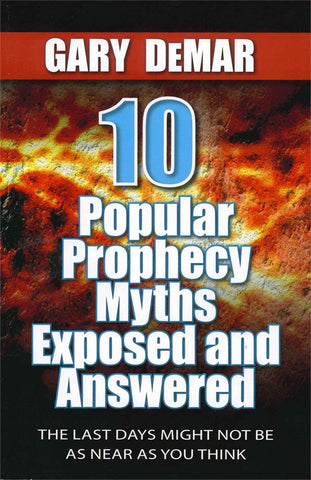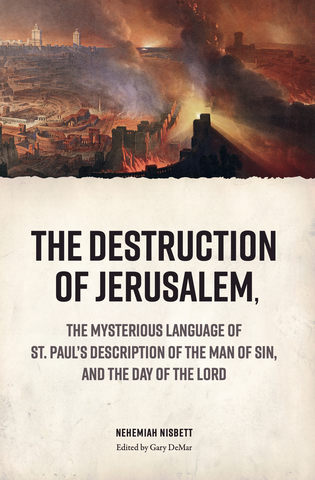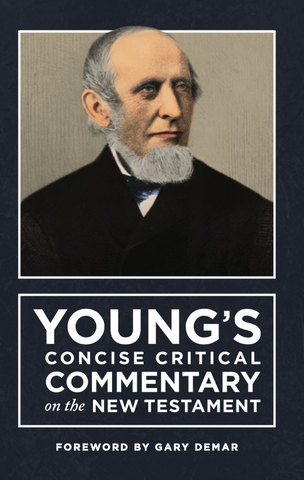(Note: This is the first part of a series)
In 2019 I wrote a review and critique of Ron Rhodes’ book Jesus and the End Times titled “Repetitive Prophecy Books Keep Getting It Wrong.” I’ll be including it in my upcoming book Prophecy Wars. Rhodes’ latest book from Harvest House is Bible Prophecy Under Siege: Responding Biblically to Confusion About the End Times. It’s mostly a defense of pretribulationalism. Rhodes claims, that while all eschatological positions have problems (agreed), he claims that “pretribulationalism has the fewest difficulties when compared to midtribulationalism, posttribulationalism, the pre-wrath view, the partial rapture view, and the preterist view.” (8-9) I’ll lay may cards of the table early: There is no such biblical doctrine known as the “rapture.” Each of these rapture positions assumes the legitimacy of other prophetic doctrines that also lack biblical support. There is no verse in the NT that says the church will be taken off the earth before, during, or at the end of a seven-year period. Not a single verse! I found the following from Rhodes curious:
With millions vanishing off the planet in the blink of an eye, people all over the world will be grasping for answers. This event will probably make global headlines. Videos of people vanishing will no doubt go viral on the internet. (32)
The NT does not say anything like what Rhodes and others claim. This is pure inference to support a doctrine that has no specific proof texts. Given that description, no one in nearly 2000 years would have ever conceived of such a scenario given the paucity of biblical support. Rhodes appeals to Revelation 18:20 as evidence that the “saints” must “include the church.” (34) The “saints and apostles and “prophets” were martyrs. They didn’t make it to heaven in a rapture. This would have included Stephen, James the brother of Jesus, and most likely Paul and Peter, and who knows how many others who perished during that Apostolic generation in that past “great tribulation” (Matt. 24:21).
Anyone familiar with the pre-trib view knows that there are no signs that precede it, otherwise the “rapture” could not always be “imminent,” that is, at any moment through the past 2000 years. But Rhodes writes “that the signs of the times [our times] are relevant to us because these signs are an indicator of the end times.” (44). If this is true, then the “rapture” couldn’t have been at any moment in the past because it’s only today’s signs that indicate the “rapture” is near. He expands on his point:
Many wonder what the relationship is between the signs of the times and the rapture. After all, the signs of the times deal specifically with the tribulation period. Here is the significance: If we witness the stage currently being set for a prophecy relating to the future tribulation period (such as the rebuilding of the Jewish temple, or the development of a one-world-government, or the movement toward globalism), since the rapture precedes the tribulation period. If the tribulation is near, then the rapture is even nearer.” (45)
On page 208, Rhodes writes what is a contradiction when compared to what he wrote on page 45: “The term imminent means ‘ready to take place’ or ‘impending.’ The New Testament teaches that the rapture is imminent—that is, there is nothing that must be prophetically fulfilled before the rapture…. The rapture is a signless event that can occur at any moment.” He can’t have it both ways.
Notice that Rhodes uses word “near.” Does his use of “near” have the same meaning of “near” in Revelation 1:3 and 22:10 and James 5:9? I’ll deal with this question when I evaluate his comments from Chapter 6 (“Examining the Preterist Case for the ‘Soon’ Fulfillment of Prophecy”) in a future article.
I deal with the “any moment rapture” belief system and how it is rarely followed by pre-tribbers in my book 10 Popular Prophecy Myths Exposed and Answered.

Ten Popular Prophecy Myths Exposed and Answered
As a result of many failed predictions, many Christians are beginning to take a second look at a prophetic system that they were told is the only one that takes the literal interpretation of the Bible seriously. Gary DeMar has taken on the task of exposing some of the popular myths foisted upon the public by prophetic speculators.
Buy NowAs with all the rapture views, the “seven-year tribulation period” is fundamental. It’s odd, therefore, that the book of Revelation never mentions “seven years,” and yet chapters 4-19 are said to be all about the seven-year tribulation period. The number “seven” is used many times in Revelation, but never “seven years.” Seems odd. I deal with this point in my book Last Days Madness.
The “wrath” mentioned in 1 Thessalonians 5:9 was described by Paul in 2:16. Paul was not describing some far distant wrath; he was describing a wrath that was imminent for his time. Note the audience references (you, them, your countrymen, the Jews) and the timing (has come):
For you, brethren, became imitators of the churches of God in Christ Jesus that are in Judea, for you also endured the same sufferings at the hands of your own countrymen, even as they did from the Jews, who both killed the Lord Jesus and the prophets, and drove us out. They are not pleasing to God, but hostile to all men, hindering us from speaking to the Gentiles so that they may be saved; with the result that they always fill up the measure of their sins. But wrath has come [aroist] upon them to the utmost (vv. 14-16).
Rhodes and others use 1 Thessalonians 4-5 to support a series of yet future events. But it’s clear from what Paul states in the fifth chapter of Thessalonians was on the horizon for them: “We who are alive” (1 Thess 4:15) and “For God has not destined us for wrath” (5:9). The “wrath” in chapter two is the same “wrath” in chapter five. Same wrath but different outcomes. Nehemiah Nisbett offers a helpful commentary:
It is a remarkable fact, that the Apostle, in his first epistle to the Thessalonians, denominates the Jews as a nation, as the common enemies of mankind; and that by their flagitious [vicious] conduct in killing the Lord Jesus and their own Prophets, and their forbidding them to speak to the Gentiles that they might be saved, they were proceeding εις το αναπληρωσαι [eis to anaplērōsai] completely to fill up the measure of their iniquities [1 Thess. 2:16; also Acts 7:51-52], as a vessel or measure is filled up till it can hold no more; and that, in consequence of their extreme wickedness, wrath was coming upon them to the uttermost. So, in Matthew 23, our Lord describes, with great particularity and minuteness, the flagitious character of the Rulers of the Jews, charging them with crimes of the deepest dye, and towards the close of the chapter, he has this remarkably striking expression, delivered in the form of a prediction—Ye will fill up yourselves the measure of your Fathers, i.e., of the Iniquities of your Fathers [Matt. 23:32].[1]

The Destruction of Jerusalem
American Vision has updated the typesetting and combined the two books into a single volume under the title The Destruction of Jerusalem, the Mysterious Language of St. Paul’s Description of the Man of Sin, and the Day of the Lord. All the Greek words have been transliterated. Quoted and referenced Scripture passages have been added where Nisbett does not include them. The notes have been included as footnotes using standard numbering. This new version of Nisbett’s two outstanding apologetic works is a welcome addition to any Christian’s library.
Buy NowFor Rhodes, the pre-trib rapture is the lynchpin of his prophetic system, and as I mentioned earlier, there is no verse that anyone can turn to support the doctrine. Revelation 4:1 does not support the pre-trib rapture of the church. The claim is often made that while the words “church” and “churches” are mentioned 19 times in Revelation 1-3 (something Rhodes points out), “the church” is not found in chapters 4-19. This means, so the argument goes, the church must have been raptured at 4:1. Nonsense. Revelation mentions seven individual churches (1:4, 11, 20) and “the church in Ephesus … Smyrna… Pergamum… Thyatira… Sardis… Philadelphia… Laodicea” (2:1, 8, 12, 18, 3:1, 3:7, 14) and churches (plural) generally (2:7, 11, 17, 23, 29; 3:6, 13, 22), not some future worldwide “the church” being taken off the earth. Let’s not forget how the seven-year tribulation period is manufactured by separating the 70th week from the other 69 weeks and placing a gap that’s nearly 2000 years long so far between them (Dan. 9:24-27). For those who are interested in a refutation of the rapture doctrine, see my book with Frank Gumerlock, The Rapture and the Fig Tree Generation.
Rhodes muddies the prophecy waters with a chapter on “replacement theology,” that the “church replaces” Israel as if the NT’s use of the word ekklēsia, translated church, is something new in the NT. Ekklēsia is a common Greek word that’s found in the Greek translation of the OT, in Matthew 18:17, the book of Acts, and elsewhere in the NT. Tyndale translated ekklēsia as “congregation” and “assembly.” Stephen uses ekklēsia in Acts 7:38 as “the ekklēsia in the wilderness,” a reference to Israel. The KJV translates the verse as “the church in the wilderness” and does the same in Hebrews 2:12. The ekklēsia in Acts 5:11 was made up exclusively of Jews. The same is true of “the church in Jerusalem” (8:1, 3). I cover this topic more thoroughly in my book 10 Popular Prophecy Myths Exposed and Answered. There is no replacement of Israel by the ekklesia.
Instead of rehashing refuted critiques of pretribulationalism, I want to spend time on Rhodes’ interaction with preterism. I’ll give him credit for the attempt but not the result.
He begins in chapter 5 with “Examining the Preterist Case for an Early Date of Revelation.” He begins by an appeal to Revelation 11:1-2 and the measuring of the temple by John:
Then there was given me a measuring rod like a staff; and someone said, “Get up and measure the temple of God and the altar, and those who worship in it. Leave out the court which is outside the temple and do not measure it, for it has been given to the nations; and they will tread under foot the holy city for forty-two months.
If Revelation was written in the mid-AD 90s as Rhodes contends, then there would not have been a temple to measure since it was destroyed in AD 70. Since the NT doesn’t say anything about a rebuilt temple, then logically this seems to refer to the rebuilt temple in Jerusalem that was completed in AD 63.
Rhodes argues that “John is mystically transported to the future vision and speaks about future events that will one day unfold (see Revelation 1:10, 19; 4:1).” These “future events” were “about to take place” (Rev. 1:19). The Greek word is mellō is used and means “about to.” Here’s how Robert Young explains its use in his Concise and Critical Commentary on the New Testament on Revelation 1:19: “WRITE] at once [therefore], the things thou didst perceive .. are about to happen after (or with) these.” What John was seeing in his day were followed by events that were “about to happen.” Rhodes assumes a gap while Young and others do not.

Concise Critical Commentary on the NT
A concordance lists most every word in the Bible and gives its English translation. A concordance like Strong’s Exhaustive Concordance also serves as a basic Bible dictionary. Strong’s comes in printed and electronic forms. It is keyed to the KJV. This is why a literal translation of the Bible is helpful. In addition to his Analytical Concordance to the Bible—where the original Hebrew or Greek words are listed as well as the pronunciation—Robert Young (1822-1888) also published several editions of his Literal Translation of the Bible (YLT). He also published the Concise Critical Bible Commentary that was "Specially Designed for Those Teaching the Word of God."
Buy NowRhodes then argues that “reference to a temple by a spokesman for God does not require the actual existence of a temple.” (82) This is curious for someone who claims to interpret the Bible literally. If this is true, then this supposed future temple may not actually exist. This is a dilemma for a prophetic view that claims the temple will be built again even though the NT does not say anything about another rebuilt temple. Rhodes continues with this statement: “If both Daniel and Ezekiel prophesied about a temple when there was no temple in existence in their day, couldn’t we expect John to follow the same pattern?” (82, italic in original). John is not prophesying about a future rebuilt temple. The temple he was told to measure had worshippers in it. Prior to AD 70 when the temple was destroyed, it was a functioning temple. Ezekiel does not measure the temple because it did not exist because it was a visionary temple. Notice what Ezekiel’s prophecy states:
So He brought me [Ezekiel] there; and behold, there was a man whose appearance was like the appearance of bronze, with a line of flax and a measuring rod in his hand; and he was standing in the gateway (Ezek. 40:1-3).
Thomas Ice made a similar mistake:
Ezekiel, during a similar vision of a Temple (Ezek. 40-43) was told to measure that Temple. When Ezekiel saw and was told to measure a Temple there was not one standing in Jerusalem (Preterists agree). Thus, there is no compulsion whatsoever to conclude that just because a temple is referenced in Revelation 11 that it implies that there had to be a physical Temple standing in Jerusalem at the same time.[2]
Rhodes references Mark Hitchcock, an advocate for the Domitian date for the composition of Revelation around AD 95, and writes, “Mark Hitchcock suggests that an early date ultimately makes the book of Revelation irrelevant for most Christians” (86). If the events prophesied in Revelation are yet to be fulfilled, then it’s been irrelevant for Christians for nearly 2000 years! In addition, following his logic, the entire Bible would be irrelevant for Christians because most of it is preterist, that is, the events have already taken place.
There are many internal and external proofs for the pre-AD 70 composition of Revelation. Many of the late-date arguments are based on external evidence. For an update on the external evidence, I suggest that the reader consult Francis X. Gumerlock’s “External Evidence for an Early Date of Revelation: Ten Early Date Traditions in Ancient Christianity.” Gumerlock’s work is based on his own Latin translation work. While external evidence is helpful, it is not unanimous or authoritative. Here is Gumerlock’s conclusion:
Regarding our brothers, like Philip Schaff, who in the early twentieth century made the claim that the Domitianic dating of Revelation was the only tradition of early Christianity, latitude can be shown for their inaccurate statements; perhaps the patristic texts illustrating the variety of opinions prevalent in the early church and middle ages were not readily available to them. But now that so many of these texts have been brought to light, it seems to me that in the twenty first century there is no excuse for making the assertion that the church fathers were all agreed on the Domitianic date of Revelation, or that such dating was the exclusive view of the early church. For, in dating the Apocalypse before 70 AD, at least ten different traditions from ancient and medieval Christianity have been preserved.
Ron Rhodes’ book does not plow any new ground. His arguments are dated, incomplete, and often inaccurate all designed to support the already refuted pretribulational and dispensational views.
James B. Jordan wrote,
We have to remember that we only have a few Church Fathers to draw on. Often Christian scholars have strained mightily to build on evidence from these writings, writings of men clearly not familiar with the facts in other instances. Many of the Fathers were new converts to the faith who wrote apologetics, and who did not know much about Christianity (as can be seen when we compare them with the teachings of the New Testament). What we don’t have are reams of sermons preached by pastors in local churches during the first two centuries, and that is the kind of material that would give us an accurate picture of the early church….
Jordan’s point is something to keep in mind. We have tens of hundreds of thousands (maybe millions) of sermons, books, commentaries, and articles on any number of biblical topics. This is not the case when we read the writings of some of what those men wrote. There remain many works that have not been translated.
[1] Nehemiah Nisbett, The Destruction of Jerusalem, the Mysterious Language of St. Paul’s Description of the Man of Sin, and the Day of the Lord (Powder Springs, GA: American Vision, [1787 and 1808] 2023), 105.
[2] Thomas Ice, “The Date of the Book of Revelation” (May 2009).

